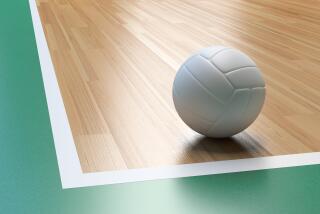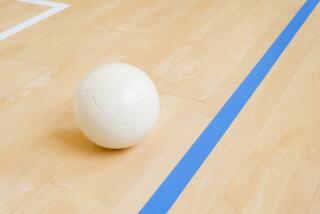Two Boys’ Teams From the San Diego Volleyball Club Are Headed for the Junior Olympics, Taking Another Step in the Right Direction : Setting Examples
- Share via
SAN DIEGO — During the late ‘60s, guys such as Chris Marlowe, Digger Graybill and Fred Featherstone moved to San Diego, volleyball in hand, and tried to make it the next Orange County or Los Angeles for the men’s side of the sport.
Featherstone and Graybill were pioneers at several local high schools in the early ‘70s, and Marlowe led San Diego State to the NCAA national championship in 1973--still the only Division I national team title for the Aztecs. But over the next 15 years or so, the sport has made few further inroads.
Featherstone is giving it another shot, this time by coaching the boys’ 18-and-under team for the San Diego Volleyball Club. The club will send teams in the 16- and 18-and-under age groups to the Junior Olympics Monday through Saturday in Toledo, Ohio. In their first trip to the event last year, the 16-and-under team finished tied for ninth and the 18s were 13th in 32-team fields.
The boys have a long way to go to get close to the success of the girls’ program--one of the best in the nation. The girls’ 18-and-under team was fourth nationally in 1986 and 1987 and third last year. And 14 players on the this year’s girls’ team have received scholarships to play collegiate volleyball.
The girls’ portion of the Junior Olympics has 350 teams competing in four age groups. The boys’ draw is simply come as you will.
But boosted by the addition of boys’ volleyball as a sanctioned sport in San Diego Section high schools, interest has been rekindled. The SDVC had its first boys’ program last year, and this year there was a 50% increase in participation.
“If we can get a couple of boys a year on (college) scholarship, that would be going in the right direction,” said Dick Templeman, the club director. “I’d just like for the boys to get a couple years of volleyball under their belts, like most kids have a couple years of Little League or flag football under their belts by the time they get to high school. Kids at that age (high school) tend to gravitate towards the sports they are good at. They aren’t good at volleyball because there is nowhere to play.”
Operating on the theory that success breeds interest, Featherstone hopes that this time the sport will stick.
One of the problems for San Diego is that there are fewer than a half dozen local players competing at the Division I collegiate level, and none have reached All-American status.
Featherstone hopes some current members of the 18s team will eventually reach the upper levels in college and provide incentives for future players.
Featherstone said two of the current players who have the tools to make an impact on the college level are Eric Sullivan and Al Mikaele.
Sullivan helped lead San Dieguito to the first section title as a sophomore and this year led the Mustangs to the 3-A title. One college coach has said that Sullivan, a middle blocker, could be the best high school player to come out of San Diego County.
And Mikaele, a sophomore from Lincoln, has the potential to be even better, Featherstone said.
“He’s the only guy on my team who can coast and still look great,” he said.
Mikaele at first wasn’t interested in joining the SDVC. Featherstone saw him playing at the Federal Building in Balboa Park.
“I just went over there to referee a match, and he was just bouncing balls all over the top of the net,” Featherstone said. “He’s got a lot of potential.”
Mikaele, who was born in American Samoa, eventually decided to try out for the team after talking with his favorite player, Allen Allen, a four-time All-American at Hawaii.
“He’s the guy who really made me want to play,” Mikaele said. “He’s the first Samoan guy I’ve seen play at Division I, so I want to be like him.”
Mikaele also knows how far San Diego has to go to catch up with Orange County and Los Angeles. He moved to San Diego last summer from Huntington Beach, where he played volleyball in junior high school.
“They are much bigger up there,” Mikaele said. “Here they have one, two, maybe three good players on a team. Up there they are all good. Even the ones who don’t get to play. But I think we can do pretty good. As long as we have a volleyball program and the coaches go out and find kids that want to play.”
Which is one of the problems facing the boys’ program. The SDVC has not been able to field teams in the 12- or 14-and-under divisions because of a lack of interest. And getting boys started at an earlier age is going to be the key for the sport here.
“We’re hoping there will be one next year,” Templeman said. “We started out with 10 kids (in the 14-and-under), and it quickly diminished from there. There just wasn’t enough interest.
“I think it’s going to take at least three more years of club ball experience and at younger ages (to compete with Los Angeles and Orange County). In order to have large growth in boys’ volleyball, we’re going to have to have kids compete in club ball earlier; otherwise when they get to high school, volleyball is going to be their fourth or fifth choice.”
More to Read
Go beyond the scoreboard
Get the latest on L.A.'s teams in the daily Sports Report newsletter.
You may occasionally receive promotional content from the Los Angeles Times.






